Bettencourts 1200-2000
Generation Seven
12. Collard de Bethencourt (Regnault, Regnault, Jean, Regnault, Philippe, Jean)32,32 was also known as Collard de Bettencourt.9 He was also known as Collenet de Bethencourt.65 He was also known as Nicolas de Bethencourt.61 He was also known as Colinet de Bethencourt.61 He was also known as Collant de Bethencourt.61 He was born circa 1400 at Caux, France.32 Collard de Bethencourt was Lord of Saint-Morys, France, and Mauquenchy.67 Regnault (V) passed the fief of Béthencourt to his son Collard.33 He married Tiphaïne Hurpé at France.65 Collard passed the fief of Béthencourt to his daughter Jeanne.33 He died before 4 Jul 1486 (his wife is described as a widow).68
Tiphaïne Hurpé32 was also known as Tihaine Hurpé.9 She was born after 1400 at France.32
Children of Collard de Bethencourt and Tiphaïne Hurpé both born at Caux, France, were as follows:
-
19 i. Jeanne de Bethencourt (III) (suffix added for clarification)32,65,9,65,9 was also known as Joana de Bettencourt.9 She was born after 1435.32 Collard passed the fief of Béthencourt to his daughter Jeanne.33 Jeanne de Bethencourt (III) was Lady of the fief of Béthencourt, Sigy-en-Bray, France.32,9 She married Jean de Bethencourt (V), son of Regnault de Bethencourt (IV) and Felipa de Troyes, circa 1469 at France.69,70,71 She had no children.72 Jeanne brought to Jean (V) as her dowry the fief of Béthencourt. This re-established to a certain point Jean's financial situation.33 She died in 1472 three years after marrying.72
Jean de Bethencourt (V) (suffix added for clarification)32,55,73,55,74,9,73,55,75,9 was also known as Johan de Béthencourt.76 He was also known as João de Bettencourt (V).77,70 He was born in 1432 at Caux, France.32,78 He was a squire.76 Jean de Bethencourt (V) was Lord of Béthencourt, Sigy-en-Bray, France.76,55 He was owner of the manuscript of Le Canarien now in the Bibliothèque municipale of Rouen, ms. mm 129.
76
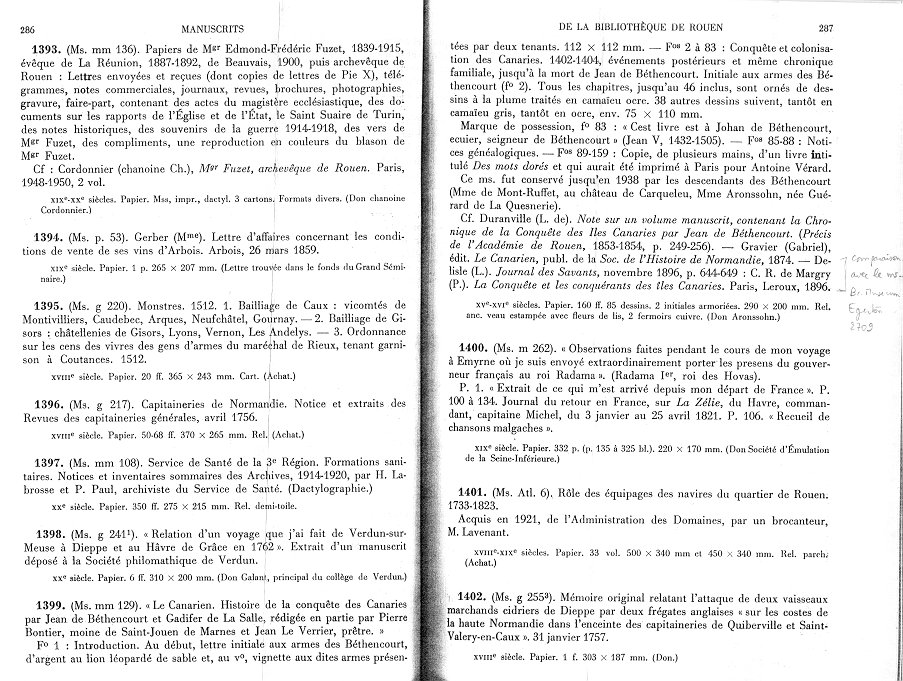 He married Jeanne de Noyon, daughter of Crespin de Noyon, in 1475 at France.72,11,55,79,9 He and Jeanne de Noyon had eight children, although the Nobiliário da Ilha da Madeira says they had six children, four sons and two daughters.80,81,79 In 1501 Jean de Bethencourt (V) received the visit of his cousin André de Bethencourt, grandson of Maciot. André and his siblings had lost touch with their relatives in Normandy. André wished to reestablish relations with the family there. Jean (V) received him cordially and gave him a summary of the Chronicle of the Canary Islands as well as information about his ancestors and a biography of Jean (IV) - with which André proposed to defend his supposed rights to the island legacy of the Conqueror.82,83 He died on 21 Mar 1506.72
He married Jeanne de Noyon, daughter of Crespin de Noyon, in 1475 at France.72,11,55,79,9 He and Jeanne de Noyon had eight children, although the Nobiliário da Ilha da Madeira says they had six children, four sons and two daughters.80,81,79 In 1501 Jean de Bethencourt (V) received the visit of his cousin André de Bethencourt, grandson of Maciot. André and his siblings had lost touch with their relatives in Normandy. André wished to reestablish relations with the family there. Jean (V) received him cordially and gave him a summary of the Chronicle of the Canary Islands as well as information about his ancestors and a biography of Jean (IV) - with which André proposed to defend his supposed rights to the island legacy of the Conqueror.82,83 He died on 21 Mar 1506.72
-
+ 20 ii. Pierre de Bethencourt (I) was born after 1450. He married Cardine Le Veneur on 18 Nov 1481 at France. He died before 1499.
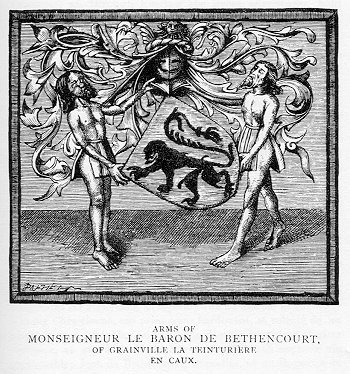
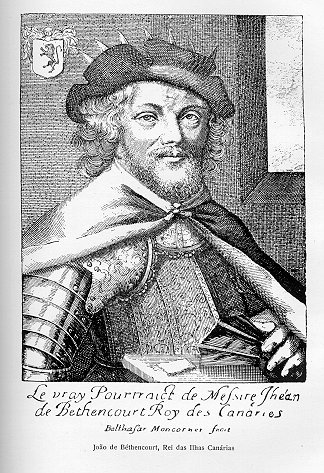
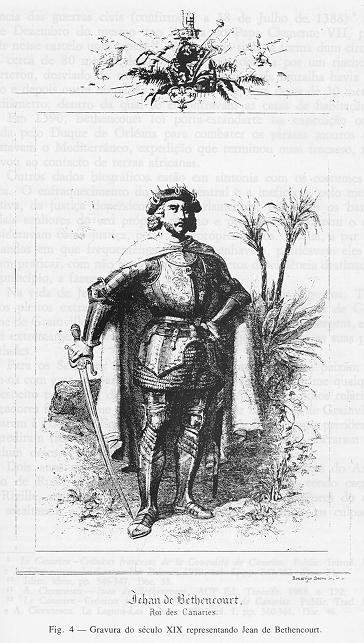
14. Jean de Bethencourt (IV) (Jean, Jean, Jean, Regnault, Philippe, Jean) (suffix added for clarification)17,35,84,85,37,38,85,39,43,41,40,32,35,86,55,24,9,56,37,32,35,86,55,24,9,56,43 was also known as Jean de Béthencourt.37,87 He was also known as João de Bethancourt.88,40 He was also known as Jehan de Bethancourt.46 He was also known as Josef de Bethancourt.38 He was also known as Monsiur João Betancur.43 He was also known as Jean de Bettencourt.44,3 He was also known as João de Bettencourt.41,89,9 He was also known as Mossem João de Betancor.90 He was also known as Jehan de Béthencourt (IV).11 He was also known as Monsiur João de Betancurt.90 He was also known as Mossior João Betencurt.91 He was also known as Monsiur João de Betancor.90 He was also known as Jhean de Bethancourt (IV).56 He was also known as Mosén Jean de Béthencourt el Grande.92 He was born in 1362 in the castle of Grainville-la-Teinturière, France.93,9,92 He spent his infancy in the castle of Grainville-la-Teinturière in the company of his mother and her brother, Mathieu de Braquemont (who was also his grandmother's second husband), and later in the company of his stepfather, Roger Suhart.93 He was educated by his uncle, Regnault de Braquemont.93 In 1373 he began to take care of the larder of the Duke of Anjou as the person in charge of the distribution of bread ("pannetier").94
In 1385 Jean gave to his brother Regnault, as part of his paternal inheritance, the manor of Grand Quesnay and the lands of Huqueleu and Mauquenchy.95,57 Between 1387 and 1391 Jean de Bethencourt (IV) was chamberlain of Louis de Valois, Duke of Touraine and later Duke of Orleans.94 On 11 Apr 1387 he obtained from the King permission to rebuild and fortify the castle of Grainville-la-Teinturière, France, previously destroyed as a consequence of civil war (confirmed 18 Jul 1388). On 9 Dec 1388, he obtained permission from Pope Clement VII to erect a chapel in the castle.96,97 In 1390 he was standard-bearer in the expedition organized by the Duke of Orleans to battle the Moorish pirates that infested the Mediterranean, an expedition that ended in a fiasco, but brought him into contact with African lands.98 According to two sources, he was never married, but these appear to be incorrect.40,46 He married Jeanne de Fayel, daughter of Guillaume de Fayel and Marguerite de Chatillon, on 30 Jan 1392 at Paris, France.99,9,24
The marriage of Jean and Jeanne was not a happy one, and in 1405, Jeanne complained to the parlement that her husband had ordered her to be confined, not permitting her to leave the house or to speak with her father and friends.100,101 He and Jeanne de Fayel had no children leaving the suggestion that his children were illegitimate.102,57,9,24 He had children; among his descendents was the venerable Pedro de Bettencourt, great apostle of America in the seventeenth century.41 After 1402 Jean de Bethencourt (IV) and Dona Maria de Ayala e Vargas had a relationship which produced a son.103 He was Lord chamberlain of the royal household for Charles VI, King of France.3
Jean de Bethencourt (IV) was a squire of Charles VI of France.88,41,104,56 He was Lord of Grainville-la-Teinturière, France.105,57,106,56 He was chamberlain of Charles VI of France at the Palace of Saint Paul, Paris, France.2,44,88,41,94,35 He was a squire of Philip , Duke of Burgundy circa 1400.104 Jean de Bethencourt (IV) was Lord of Béthencourt, Sigy-en-Bray, France, Saint Saire, Lincourt, Riville, Grand Quesnoy, Huqueleu, and Baron of Saint-Martin-le-Gaillard, etc.107,57,24,56,92
He developed the desire to explore the Canary Islands.2,88,87 In Dec 1401 he sold his house in Paris, valued at 200 gold francs, and some other small pieces of property to obtain the necessary financing for his expedition to the Canary Islands. Since the amount realized was insufficient, his uncle, Robert de Braquemont, loaned him 5,000 pounds (to which he later added another 2,000), Jean to all intents mortgaging to him the fiefs of Béthencourt and Grainville.108 Having conceived the project of conquering the Canaries, which were then only frequented by merchants or Spanish pirates, he assembled a body of adventurers, among whom was a knight named Gadifer de La Salle, who joined him at La Rochelle, France. Bethencourt took with him his two chaplains, Brother Pierre Bontier, a Franciscan monk of St. Jouin de Marnes who later officiated at Lanzarote in the church of St. Martial de Rubicon which Bethencourt built in the castle of that name, and Jean le Verrier, a priest who was later installed at Fuerteventura as vicar in the chapel of Our Lady of Bethencourt; they were the historians of the expedition.109
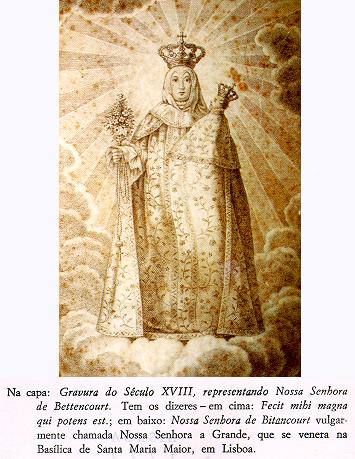
Two early manuscripts exist detailing the story of Le Canarien. One is ms. Egerton 2709 in the British Library in London which gives preference to Gadifer de La Salle. The other, ms. mm 129 of the Bibliothèque municipale in Rouen, France, gives preference to Jean de Bethencourt. It was this latter copy which was formerly in the possession of the Béthencourt family.
110
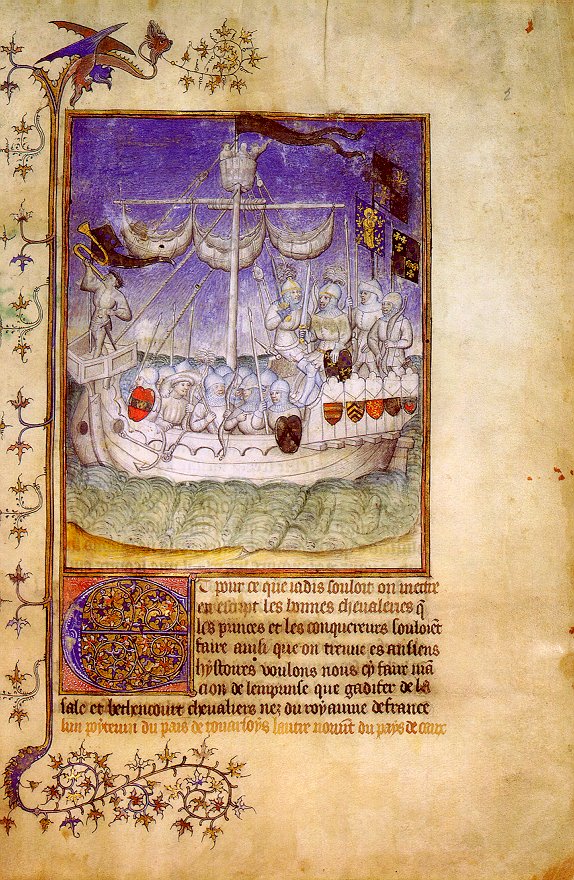
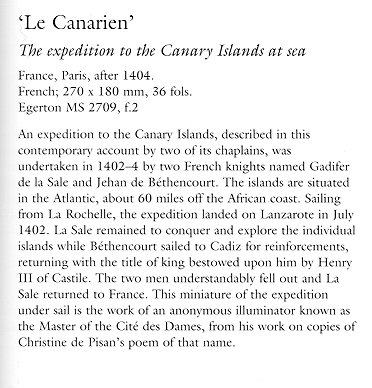 They started the expedition 1 May 1402 from La Rochelle, France, putting in at Corunna and at Cadiz, where they stayed till the month of July, the party meanwhile becoming reduced by the desertion of twenty-seven men to only fifty-three in number. Eight days from Cadiz brought them to the island of Graciosa; from there they went to Lanzarote, landing on 30 Jun 1402, where they were well received and obtained permission to build a fort which they named Rubicon. Leaving Bertin de Berneval in charge, Bethencourt went with Gadifer to Fuerteventura but was obliged to return to Lanzarote on account of mutiny among his sailors and lack of provisions. While at Fuerteventura, Robin le Brument, master mariner of a ship which Gadifer affirmed to be his own, refused admission to Gadifer and his companions, but agreed, on condition of receiving hostages, to carry them over to Lanzarote.111,112,3
They started the expedition 1 May 1402 from La Rochelle, France, putting in at Corunna and at Cadiz, where they stayed till the month of July, the party meanwhile becoming reduced by the desertion of twenty-seven men to only fifty-three in number. Eight days from Cadiz brought them to the island of Graciosa; from there they went to Lanzarote, landing on 30 Jun 1402, where they were well received and obtained permission to build a fort which they named Rubicon. Leaving Bertin de Berneval in charge, Bethencourt went with Gadifer to Fuerteventura but was obliged to return to Lanzarote on account of mutiny among his sailors and lack of provisions. While at Fuerteventura, Robin le Brument, master mariner of a ship which Gadifer affirmed to be his own, refused admission to Gadifer and his companions, but agreed, on condition of receiving hostages, to carry them over to Lanzarote.111,112,3
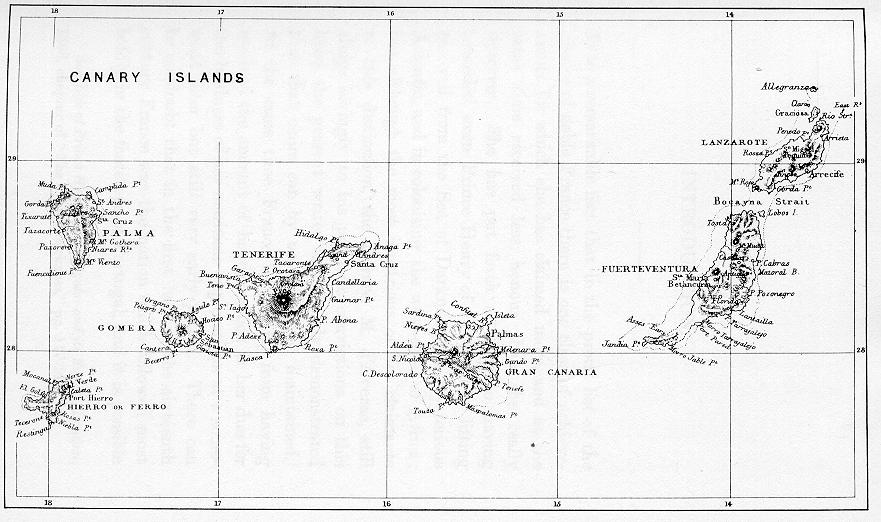
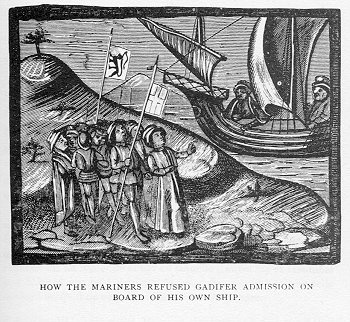 Although some sources indicate that Bethencourt discovered the Canary Islands, it would be more appropriate to say that he conquered and settled them as well as converting the inhabitants to Catholicism.38,44,43,40,46,32,35,3,57 The museum of the church of Santa Maria de Betancuria in Bethencuria, Fuerteventura, contains a replica of the banner carried by Bethencourt when he seized Fuerteventura.113
Although some sources indicate that Bethencourt discovered the Canary Islands, it would be more appropriate to say that he conquered and settled them as well as converting the inhabitants to Catholicism.38,44,43,40,46,32,35,3,57 The museum of the church of Santa Maria de Betancuria in Bethencuria, Fuerteventura, contains a replica of the banner carried by Bethencourt when he seized Fuerteventura.113
It was resolved that Bethencourt should go to Spain to get together what was necessary to complete the enterprise.88,114,115 Gadifer remained as lieutenant, and while he was absent at the Isle of Lobos, Bertin excited disaffection against him, drew together a faction of his own with which he pillaged the castle of Rubicon and took a number of natives prisoner on 25 Nov 1402, including Guardarifa, the King of Lanzarote, who had already made friendly submission to Bethencourt. Two Spanish ships had arrived meanwhile, and Bertin, having gained over Ferdinand Ordoñez, captain of the Tranchemar, took his spoils and prisoners on board, abandoned his followers to perish miserably in Africa, and went himself to Spain.
The unfortunate Gadifer was left by this treachery on the island of Lobos without the supplies he expected to follow him, until the captain of the other Spanish ship, the Morelle, sent a canoe to his rescue and he returned to Rubicon. Here he found affairs in a sad state, no provisions, no stores, and an insufficient number of men to keep the natives in check.116,117 Meanwhile, Bethencourt was obtaining from Henry III, King of Castile, the supplies he wanted, on condition of doing homage. Castilian documents of 26-28 Nov 1402 refer to the lordship of the Canary Islands and the requested aid: 20,000 maravedis (old Gothic coin formerly used in Portugal and Spain), soldiers, arms, and provisions. Having sent his wife home in the charge of Enguerrand de la Boissière, he preferred to return to Lanzarote.88,118,119 On 10 Jan 1403 Bethencourt was solemnly invested by Henry III, King of Castile, with the government of the Canary Islands.120,121,35 He was referred to as Jean de Ventancorto in documents in Spain.122 Between 1404 and 1406 Jean de Bethencourt (IV) was King and Lord of the Islas Canarias.37,44,43,46,87,35,123,3,57,9,26,56 Some documents refer to him as Governor of the Islas Canarias.88,41,35 Bethencourt had learned the state of affairs on the arrival of the ship Morelle in Spain, which preceded by a short time the Tranchemar, in which the traitor Bertin arrived with his captives, and sent help to Gadifer from the king with directions to follow up the explorations.
Gadifer had been to Fuerteventura, Gran Canaria, Ferro, Gomera, and Palma (all part of the Canary Islands), and returned to Rubicon after a voyage of three months. He had sent a ship to Spain with the account of his expedition, but Bethencourt himself now arrived at Rubicon (Os Bettencourt gives the date as 19 Apr 1404 but this appears to be too late, a date earlier in Feb seeming more likely) where he was received with great demonstrations of joy. He proceeded vigorously with the conquest of the natives. Finally, the king of Lanzarote submitted and asked for baptism on 20 Feb 1404, which he received with many of his people. After this, Bethencourt and Gadifer were only withheld from further conquest by want of aid from the courts of France and Spain, though application was made especially to the former. On their return from an expedition to the coast of Africa in 1404, Gadifer showed discontent that Bethencourt had not considered his interests when he did homage to the King of Castile for the government of the islands. However, he took part in an expedition against Gran Canaria on 25 Jul 1404, but the dispute was afterwards renewed, and on 9 Oct Gadifer set out for Castile to plead his case with the King. Finally, however, Gadifer, unable to prevail against Bethencourt's greater influence at the court of Castile, gave up his own cause in despair and returned to France.124,125
The Ascendência e Descendência do Conselheiro Nicolau Anastácio de Bettencourt gives Marguérite de Béthencourt's father as Jean IV instead of Maciot. It also states that Jean IV married a second time, in 1415, to Lerize Guardateme, Princess of the Royal House of the Canarias and Lady of the Island of Lanzarote, Marguérite's mother. In a note, however, it states that various authors give Marguérite's father as Maciot.56
Bethencourt had several encounters with the natives, but maintained his authority successfully, and the two kings of Fuerteventura, together with their people, became Christian in Jan 1405 (Os Bettencourt gives the dates as 18 and 25 Feb 1405 for each king). On 31 Jan 1405, he went to France to obtain the materials for forming a colony, was warmly welcomed at Grainville, and obtained all he required.
He left Honfleur on 9 May 1405 and returned to Lanzarote with his nephew, Maciot de Bethencourt, and was received with great joy by his own people, as well as by the inhabitants of Fuerteventura.126,127 On 6 Oct 1405 he set out on his expedition to Gran Canaria which was unsuccessful from various causes, but in Palma and Ferro, after some opposition, he formed colonies.128,129
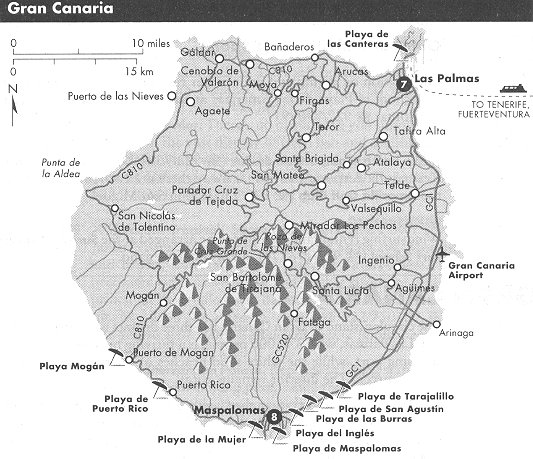 Returning to Lanzarote, he arranged everything for the good government of the islands which he had conquered and civilized, and leaving his nephew, Maciot de Bethancourt, as governor-general, he departed universally regretted on 15 Dec 1406.88,43,41,40,46,87,130,131,132 He went to Spain where the king received him warmly and gave him letters of recommendation to the Pope, from whom he was anxious to obtain the appointment of a bishop for the islands. At Rome, he was well received by the Pope, who granted all he required. He then returned to France by way of Florence where he was feted by the government. Then he went to Paris and so to his own house.133
Returning to Lanzarote, he arranged everything for the good government of the islands which he had conquered and civilized, and leaving his nephew, Maciot de Bethancourt, as governor-general, he departed universally regretted on 15 Dec 1406.88,43,41,40,46,87,130,131,132 He went to Spain where the king received him warmly and gave him letters of recommendation to the Pope, from whom he was anxious to obtain the appointment of a bishop for the islands. At Rome, he was well received by the Pope, who granted all he required. He then returned to France by way of Florence where he was feted by the government. Then he went to Paris and so to his own house.133
An indiscreet, though perfectly innocent, word from Madame de Bethencourt with reference to her brother-in-law, Regnault de Bethencourt, produced an estrangement between her and her husband whose jealous cruelty would seem to have brought about her early death. At a festivity in honor of her husband upon his return to France from the Canary Islands, she commented to him that she should have married his brother Regnault, while Jean should have married her sister who was much older, more of an age with Jean himself.134 A feeling of revenge led Jean to impoverish as far as possible the property to which his brother would be the successor. It is but justice to say that before his death he saw his error, and on his deathbed was anxious to declare repentance to the brother whom he had injured.135 He married Françoise de Calletot at France.136 In 1417 Regnault gave certain lands to his brother Jean (referred to in the grant as Lord of the Canaries).43
On 13 Jun 1417 Jean de Bethencourt paid homage to King Charles VI of France for his feudal benefice of Bethencourt in Normandy.137,26 On 17 Oct 1418 Jean confirmed the powers previously granted to his nephew Maciot, permitting him to sell the Canary Islands with the exception of Fuerteventura which was to remain for his heirs.138 In 1419 Messire Jean de Bethencourt held the title of Baron in right of the Barony of Saint-Martin-le-Gaillard in the Comté d'Eu, where he had a strong castle which was taken and retaken several times in the wars with England. Monstrelet speaks of its final siege and ruin in 1419. It came by inheritance to Messire de Bethencourt from his grandmother Dame Isabeau de St. Martin.139,55,140
On 16 May 1419 Jean de Bethencourt pledged fealty to King Henry V of England. The wars between England and France had already caused Bethencourt many problems and, after the capture of Caudebec in Normandy in September 1418, this pledge of fealty was the only way to safeguard his possessions.141 Bethencourt remained in Grainville for several years, receiving from the bishop news of the islands and the good government of his nephew.133 In the second half of 1425, as he was preparing to visit the Canary Islands again, he died, attended at his deathbed by his chaplain, Jean Le Verrier. Although the text of the manuscript of Bontier and Verrier places the death of Jean de Bethencourt in 1422, Bergeron, who was not an idle investigator, in fixing the date at 1425, says, "comme il appert par plusieurs actes" (as appears in several documents). So we may reasonably accept his decision.142,143,144,145,57,146,9,56 He was buried in 1425 in the choir of the church of Grainville-la-Teinturière, France.147,148,56
Jeanne de Fayel32,100,100 was also known as Jeanne du Fayel.9 She was born after 1370 at Champagne, France.32,135 Her dowry was relatively modest. It consisted of the fief and lands of Saclas in the region of Béauce, near Éstampes, and an annual rent of 200 pounds which she had inherited from her maternal grandfather, the Count of Porcin. Perhaps because of the difficulty of maintaining those estates, situated far from his home, her husband Jean sold them after three years.100 She died before 1425.149,148
There were no children of Jean de Bethencourt (IV) and Jeanne de Fayel.
Dona Maria de Ayala e Vargas150 was born circa 1370 at Seville, Spain.150
Children of Jean de Bethencourt (IV) and Dona Maria de Ayala e Vargas were:
-
21 i. Floridas Bethencourt150,150,150 was born illegitimate circa 1405 at Seville, Spain.150 After being acknowledged by his father, he was brought to the Canary Islands.150
Françoise de Calletot136 was born circa 1375 at France.136
Children of Jean de Bethencourt (IV) and Françoise de Calletot were:
-
22 i. Jacques de Bethencourt136,136,136 was born circa 1410 at France.136 He married Marie d' Estoutteville-Villebon at France.136
Marie d' Estoutteville-Villebon136 was born circa 1410 at France.136
15. Regnault de Bethencourt (IV) (Jean, Jean, Jean, Regnault, Philippe, Jean) (suffix added for clarification)32,35,13,151,37,41,35,152,55,7,24,153,154,12,43,37,35,86,55,7,24,153,154,12,43 was also known as Renault de Bethencourt.155 He was also known as Renaud de Bettencourt.55 He was also known as Reynaud de Bethencourt.6 He was also known as Reinaldo de Bettencourt.41,40 He was also known as Reynault de Béthencourt.37,35 He was also known as Reynaldo Bitancur.43 He was also known as Regnault de Morelet both sources specifically mention that Morelet is a surname.156,157,146 He was also known as Renaud de Bettencourt.29,7 He was also known as Regnault de Moreau.29,158,146 He was also known as Regnault de Bettencourt.23 He was also known as Raynaldo de Bettencourt.159 He was also known as Reynaldo de Bettencourt.26,12 He was born at France before 1364 the year his father died.29,6,153,160
In 1385 Jean gave to his brother Regnault, as part of his paternal inheritance, the manor of Grand Quesnay and the lands of Huqueleu and Mauquenchy.95,57 He was a knight.32 He married Marie de Breauté at France.73,161,55,162,9 He was Lord chamberlain of the Duke of Burgundy and of the King between 1400 and 1401.95,57,162,56 In 1402 Regnault was sent as Ambassador to Spain to persuade King Henry III to render obedience to the Pope at Avignon.95 In Feb 1405 he visited his brother Jean de Bethencourt at Grainville-la-Teinturière when Jean was home on a short visit from the Canary Islands.163 He was put in charge of the supply of bread in 1410 at Paris, France.95,57 In 1411 Regnault de Bethencourt (IV) was named captain of the guard of the castle of Longueville, France.95 In 1412 he received, in payment for his services, a house in Paris, France.95 In 1417 Regnault gave certain lands to his brother Jean (referred to in the grant as Lord of the Canaries).43
In 1419 he pledged fealty to King Henry V of England after the English had conquered most of Normandy.164 On 11 May 1421 Regnault's goods were increased by the gift which Jean (IV) made him of all his personal fortune.165,57 He married Felipa de Troyes, daughter of Guillaume de Fayel and Marguerite de Chatillon, on 14 Jul 1422 at France.41,73,35,166,55,6,7,162,9,12 As vassal of the Kings of England and of France, he performed the duties of Chief Treasurer of Normandy (1423) and Commander of the night watch of the streets of Paris (1424), a duty which he lost when the city returned to the possession of the French in 1436.165 In 1425 he inherited all his brother's goods.162,56 On 6 Apr 1426 Regnault was granted the fief of Béthencourt as well as 500 libras from the revenues of the lands of Granville which were awarded to Aldonce de Bracquemont and her husband Pierre de Rouville.33,26 In 1428 Regnault (IV) ceded the lands of Béthencourt to Regnault (V) who was creditor of Jean (IV).33 In 1434 a certificate in Latin issued in Paris in favor of Reynaldo de Bettencourt by King Henry VI, King of England who held Paris at that time, refers to his brother as King and Lord of the Canaries.26 He died in 1443.33,9
Felipa de Troyes (Os Bettencourt mentions Phillipote as sister of Jeanne de Fayel)37,33,33 was also known as Filipota de Troyes.55,6 She was also known as Felipa de Froyes.41 She was also known as Phillipote de Troyes.32,135 She was also known as Felipora de Trope.35 She was also known as Philippote de Troyes.33,9 She was also known as Phillipa de Troyes.33 She was also known as Philipotte de Troyes.11 She was also known as Filipine Froyes.12 She was also known as Philipotes Fayel des Troyes.7 She was also known as Filippota de Froyes.162 She was also known as Phelipa de Troyes.23 She was born before 1370 at Paris, France (She was older than her sister Jeanne).33,6,162,12
Children of Regnault de Bethencourt (IV) and Felipa de Troyes were as follows:
-
+ 23 i. Maciot de Bethencourt was born illegitimate circa 1390 at France.
Maciot de Bethencourt married Lerianda de Gardaleme at France. He died between 1454 and 1458 at Madeira, Portugal.
-
+ 24 ii. Henri de Bettencourt was born illegitimate circa 1390 at France. He married Marguérite de Béthencourt, daughter of Maciot de Bethencourt and Lerianda de Gardaleme, at Islas Canarias. He married Lerianda de Gardaleme at France.
-
+ 25 iii. Georges de Bethencourt was born circa 1390 at France. He married Elvira Gonçalvez de Avilla, daughter of Estevan Dominguez de Ávila and Ximena Blasquez, at Valladolid, Castile, Spain.
-
+ 26 iv. Inês de Bethencourt (I) was born circa 1390 at Grainville-la-Teinturière, France. She married Guillien de Las Casas (I), son of Alfonso de Las Casas (I), at France. There is a question as to which de las Casas brother Inês was married to. Some sources (Guía histórica del Museo Militar Regional de Canarias por Juan Tous Meliá) give Inês' husband as Juan de las Casas, who was Guillien's brother. On the other hand, Guillien is presented by some genealogists as the husband of Leonor González de Guzmán.
-
+ 27 v. Jean de Bethencourt (V) was born in 1432 at Caux, France. He married Jeanne de Bethencourt (III), daughter of Collard de Bethencourt and Tiphaïne Hurpé, circa 1469 at France. He married Jeanne de Noyon, daughter of Crespin de Noyon, in 1475 at France. He died on 21 Mar 1506.
Marie de Breauté32,135,9 was also known as Marie de Béauce.33 She was also known as Maria de Breauté.55 She was also known as Marie de Briauté.161 She was also known as Maria de Breante.162 She was born circa 1350 at France. She is mentioned as much older than her husband Regnault.73 She was Lady of Rouvray near Verneuil.33,135,162,9
There were no children of Regnault de Bethencourt (IV) and Marie de Breauté.
16. Phillippote de Neuville (Jeanne Bethencourt, Jean, Jean, Regnault, Philippe, Jean)31,31,24,31,24 was also known as Filippota de Emeville.24 She was born circa 1360 at France.31 She married Philibert Le Peley at France.31,24 In 1380 Phillippote began to receive the annual income of 50 libras which Jean (III) had given to her mother.31
Philibert Le Peley31 was born before 1350 at France.31 Philibert Le Peley was Lord of Maurepas, Gournay, France.31,24 He was granted the tutelage of his wife's step-brothers.31
Children of Phillippote de Neuville and Philibert Le Peley both born at Maurepas, Gournay, France, were as follows:
-
28 i. Jeanne Le Peley31,31,31 was born after 1380.31 She had no children.31
-
29 ii. Denise Le Peley31,31,31 was born after 1380.31 She married Jean de Bourtanvillier at France.31,24
Jean de Bourtanvillier31 was also known as Lord Bontervilher.24 He was born circa 1380 at France.31
17. Ystace d' Erneville (Jeanne Bethencourt, Jean, Jean, Regnault, Philippe, Jean)31,167,31,31 was born after 1362 at France.31 After 1365 the tutelage of Ystace and his brother was first handed over to Louis de Erneville (or Renneville) and, after his death, to Philibert Le Peley, husband of their step-sister, Phillippote.31 In Feb 1405 Erneville and his son of the same name visited Jean de Bethencourt at Grainville-la-Teinturière on his return from the Canary Islands. Erneville offered to return with Bethencourt to the Canary Islands, but Bethencourt preferred that he remain at home.168
Children of Ystace d' Erneville include:
-
30 i. Ystace d' Erneville168,168 was born circa 1385 at France.168 In Feb 1405 he and his father visited Jean de Bethencourt during his short stay at Grainville-la-Teinturière before his return to the Canary Islands.168
Return to Table of Contents
Please send e-mail to: bettencourt@meganet.net
Created with The Master Genealogist for Windows on 2 Aug 2015 at 03:12 pm.
 He married Jeanne de Noyon, daughter of Crespin de Noyon, in 1475 at France.
He married Jeanne de Noyon, daughter of Crespin de Noyon, in 1475 at France. He married Jeanne de Noyon, daughter of Crespin de Noyon, in 1475 at France.
He married Jeanne de Noyon, daughter of Crespin de Noyon, in 1475 at France.




 They started the expedition 1 May 1402 from La Rochelle, France, putting in at Corunna and at Cadiz, where they stayed till the month of July, the party meanwhile becoming reduced by the desertion of twenty-seven men to only fifty-three in number. Eight days from Cadiz brought them to the island of Graciosa; from there they went to Lanzarote, landing on 30 Jun 1402, where they were well received and obtained permission to build a fort which they named Rubicon. Leaving Bertin de Berneval in charge, Bethencourt went with Gadifer to Fuerteventura but was obliged to return to Lanzarote on account of mutiny among his sailors and lack of provisions. While at Fuerteventura, Robin le Brument, master mariner of a ship which Gadifer affirmed to be his own, refused admission to Gadifer and his companions, but agreed, on condition of receiving hostages, to carry them over to Lanzarote.
They started the expedition 1 May 1402 from La Rochelle, France, putting in at Corunna and at Cadiz, where they stayed till the month of July, the party meanwhile becoming reduced by the desertion of twenty-seven men to only fifty-three in number. Eight days from Cadiz brought them to the island of Graciosa; from there they went to Lanzarote, landing on 30 Jun 1402, where they were well received and obtained permission to build a fort which they named Rubicon. Leaving Bertin de Berneval in charge, Bethencourt went with Gadifer to Fuerteventura but was obliged to return to Lanzarote on account of mutiny among his sailors and lack of provisions. While at Fuerteventura, Robin le Brument, master mariner of a ship which Gadifer affirmed to be his own, refused admission to Gadifer and his companions, but agreed, on condition of receiving hostages, to carry them over to Lanzarote.
 Although some sources indicate that Bethencourt discovered the Canary Islands, it would be more appropriate to say that he conquered and settled them as well as converting the inhabitants to Catholicism.
Although some sources indicate that Bethencourt discovered the Canary Islands, it would be more appropriate to say that he conquered and settled them as well as converting the inhabitants to Catholicism. Returning to Lanzarote, he arranged everything for the good government of the islands which he had conquered and civilized, and leaving his nephew, Maciot de Bethancourt, as governor-general, he departed universally regretted on 15 Dec 1406.
Returning to Lanzarote, he arranged everything for the good government of the islands which he had conquered and civilized, and leaving his nephew, Maciot de Bethancourt, as governor-general, he departed universally regretted on 15 Dec 1406.